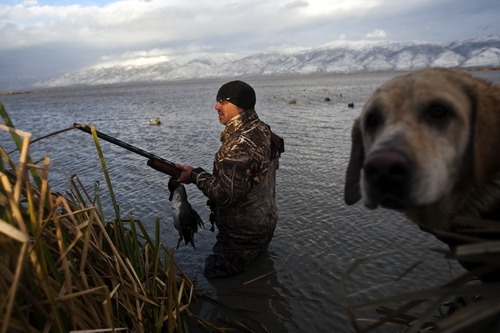This is an archived article that was published on sltrib.com in 2011, and information in the article may be outdated. It is provided only for personal research purposes and may not be reprinted.
As thousands of hunters head to Great Salt Lake marshes Saturday for the opening of Utah's waterfowl season, most would be hard pressed to put a monetary value on an activity that for many, borders on the spiritual.
But a University of Montana professor of natural resources economics has attempted to do just that. The results of his study, released Friday by a host of environmental organizations, show that waterfowl hunting on and around the Great Salt Lake is responsible for an estimated $97 million in economic activity per year, supports 1,600 jobs and provides nearly $37 million of income to Utah workers.
"In similar studies around the nation, we've found communities often undervalue the economic importances of places like the Great Salt Lake, which provide natural habitats for wildlife, but also provide significant economic values to surrounding communities," said John Duffield, the Montana expert who conducted what sponsoring groups believe is the most in-depth study ever on the opinions of hunters and the economics of hunting around the Great Salt Lake.
Duffield surveyed 556 duck hunters who utilize the Great Salt Lake for hunting to produce a 95-page report. The report is available online at http://www.fogsl.org/hunterstudy.pdf.
"My life work has been trying to make sure that fish and wildlife values are getting represented in policy decisions," said Duffield. "That involves putting a value on things not exchanged in the market, values like what is a day of hunting, fishing or watching elk worth."
The idea is to show that the economic benefits provided by hunters and wildlife watchers on the lake can compete with other uses such as mineral extraction, the release of sewage or creating dams that might adversely impact that experience.
"As hunters, we know how valuable the Great Salt Lake is as a magnet for migratory waterfowl," said Jack Ray, a duck hunter and president of the Utah Waterfowl Association, which was one of the major sponsors of the study. "This study attaches a dollar value to waterfowl hunting on the lake. While it is difficult to put an economic value on the experiences we have hunting on the lake with our family and friends, I hope this effort helps non-hunters and our elected officials understand how important it is for us to protect this incredible resource for our children and our grandchildren."
Duffield said the average public hunter pays $8,000 a year to enjoy his sport, including equipment, licenses, ammunition and other associated costs. The smaller group of hunters who belong to private clubs near the Great Salt Lake spent as much as $40,000 a year on their sport.
And he said that, though not part of this study, wildlife viewing could potentially be even more valuable economically than duck and goose hunting.
In a presentation at the Alta Club in Salt Lake City Friday, Duffield stressed the ecological importance of the Great Salt Lake, which hosts 30 percent of all waterfowl in the Pacific and central flyways of North America. The system is used by 3 million ducks and geese a year and millions more shorebirds.
He said the U.S. Fish and Wildlife Service estimates it sells 33,000 federal duck stamps in Utah. His study shows that there are 15,000 active duck and goose hunters in Utah, with 64 percent of their trips occurring around the Great Salt Lake. In an average waterfowl season, Utahns spend 210,000 days afield.
The study also asked hunters about their perceptions of important issues facing the Great Salt Lake ecosystem. More than 80 percent listed as major concerns: invasive phragmites vegetation, reallocation of waterflows from wetlands to development, absence of native marsh vegetation that attracts and feeds waterfowl, water levels in the Great Salt Lake and loss of waterfowl habit due to expansion of the mineral salt industry.
"The Great Salt Lake faces some serious threats that hunters are very concerned about," said Lynn de Freitas, executive director of Friends of Great Salt Lake, one of the study sponsors. "We hope this study helps our community as a whole understand the value of the lake and its wetlands beyond industrial purposes. If we forget the value of the natural habitat and its recreational opportunities, we're leaving out a big part of the economic picture."
wharton@sltrib.comTwitter: @tribtomwharton



